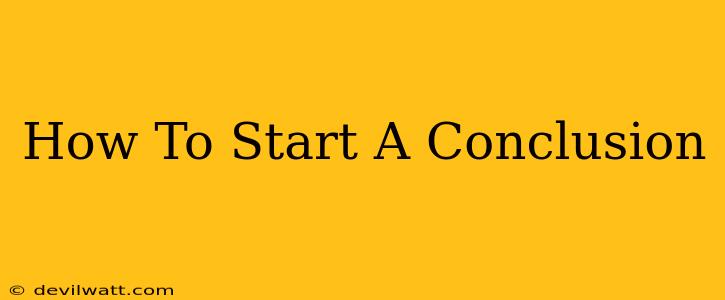Crafting a compelling conclusion is crucial for any piece of writing, whether it's an essay, a research paper, a blog post, or even a presentation. A strong conclusion doesn't just summarize; it leaves a lasting impression and reinforces your main points. But knowing how to start that conclusion can be tricky. This guide will equip you with several effective techniques to launch your conclusion with impact.
Different Ways To Begin Your Conclusion
The way you begin your conclusion significantly impacts its effectiveness. Avoid simply stating "In conclusion..." – it's overused and lacks punch. Instead, try these dynamic opening strategies:
1. Restate Your Thesis (But Make it Fresh):
This classic approach revisits your main argument, but don't just parrot your introduction. Refine it, strengthening it with the evidence you've presented. Instead of a simple rehash, offer a nuanced perspective reflecting the insights gained throughout your work.
- Example: "The initial assertion that social media impacts self-esteem negatively has been profoundly substantiated through this analysis of recent studies, revealing a complex interplay between online interaction and individual well-being."
2. Synthesize Key Findings:
Instead of listing points, weave together your main findings to create a cohesive narrative. Highlight the connections and relationships between your supporting evidence. This approach demonstrates a deep understanding of your topic.
- Example: "The research on climate change adaptation strategies, economic models, and societal shifts reveals a compelling picture of interconnected challenges requiring immediate and collaborative action on a global scale."
3. Offer a Thought-Provoking Question:
Stimulate further reflection by posing a compelling question related to your topic. This encourages your reader to engage with your work long after they finish reading.
- Example: "If artificial intelligence continues to advance at this rate, what ethical responsibilities do we, as a society, have to ensure its responsible development and deployment?"
4. Look to the Future:
Projecting forward provides a sense of closure while also offering a glimpse into potential implications or future research directions.
- Example: "The future of sustainable agriculture hinges on the adoption of innovative technologies and practices highlighted in this report, promising a path toward greater food security and environmental stewardship."
5. Use a Powerful Metaphor or Analogy:
A well-chosen metaphor or analogy can powerfully summarize your central idea and leave a lasting impact. Make sure it aligns with the overall tone and style of your writing.
- Example: "The fight against misinformation is like a never-ending battle against a hydra, where each defeated falsehood spawns two more. Only through sustained vigilance and critical thinking can we hope to prevail."
Beyond the Opening Line: Crafting a Memorable Conclusion
While a strong opening is essential, it's only the beginning. Your conclusion should also:
- Summarize key points concisely: Briefly restate your main arguments without being repetitive.
- Provide closure: Leave the reader with a sense of completeness and satisfaction.
- Offer a final thought-provoking statement: Leave a lasting impression by offering a perspective or call to action.
By mastering these techniques for starting and crafting your conclusions, you can transform your writing from simply informative to truly compelling and memorable. Remember, a strong conclusion is just as important as a strong introduction in leaving a lasting impact on your audience.

